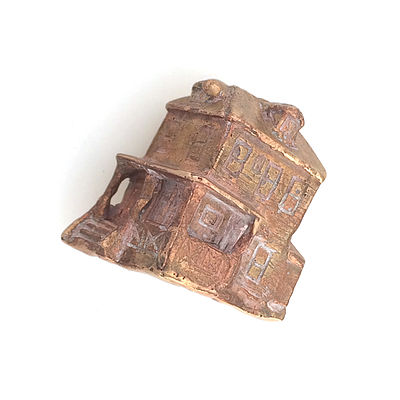Erin Rose Gardner. 2010 Individual Artist Fellow, Oregon Arts Commission.
Photo: Little House.
Originally published March, 2011
The same ring appears again and again in Erin Rose Gardner’s early work. A sliver of a ring with settings for four stones, it shows up in pairs and trios of identical casts connected into unwearable forms, as an impression in a broach, as if it had been covered with a layer of clay, then cast in precious metal. But it’s perhaps most poignant as a shadow, its four settings appearing to rise up from underneath the blanket of a broad band of gold.
Recipient of a 2010 OAC Individual Artist Fellowship, Erin Rose Gardner is a conceptual jeweler, one for whom the idea behind the piece is as important as the work itself, its form and material.
In many ways the recurring motif of that one ring-a promise ring given to her by a high school sweetheart-its function as a repository of emotion, of sentiment, of memory, but also its mass-produced nature (it was a Fred Meyer purchase), has continued to shape her work to this day. Gardner has said that she she is developing a “craft-based body of work using mass-production as a subject.” But it’s a more expansive subject, really, touching on both the psychology and sociology of jewelry. She’s interested in the value we assign to a fine craft object and where that might intersect and overlap with the value society assigns to the mass-produced jewelry object, particularly as accepted signifier of love and devotion.
Gardner graduated from the University of Oregon and immediately received a 2007 Windgate Fellowship to allow her to travel to England and China to research the past and present of the mass-production of jewelry. In Birmingham, she explored the process of drop-stamping, a method for stamping annealed metal into forms like St. Christopher medals, military regalia, and brush backs. In China, where there are more than 900 jewelry processing centers, Gardner visited factories around Shanghai and in Guangdong providence, the source of nearly all jewelry that ends up in American shopping malls. She visited markets where waxes of rings not unlike her promise ring from long ago are displayed by the thousands in tray after tray, each varying only ever so slightly from the last.
These masses of the mass-produced show up in her more recent necklaces with heart-shaped tangles of tacky, and familiar, heart pendants, some broken. She borrows jewelry from friends to cast and scours pawn shops for the shelved tokens of affection. Gardner further plays with the line between precious and non- by casting elements in silver, but then powder coating them, sometimes hot pink.
With fellow U of O grad Meg Drinkwater, Gardner co-founded The Opulent Project which shares concerns of her own practice, but uses mass-production methods and non-precious materials to create jewelry that is sold in places like the Museum of Modern Art and the Cooper Hewitt National Design Museum. The Opulent Project was launched with earrings cut from exit sign plastic in the shapes of the silhouettes of jewelry belonging to royalty, playing with making the inaccessible and precious, accessible and non-precious. The two have since expanded The Opulent Project into a collective whose most recent project was an exhibition at Tractor Gallery in December. Costume Costume asked a number of conceptual jewelry artists to make work based on costume jewelry.
Costume Costume was not their first foray into curating, the two also curate exhibitions at 18K Gold Tone, their project space in Portland.
http://erinrosegardner.com
theopulentproject.com
18kgoldtone.com
Courtesy of The Oregon Arts Commission.
Artist Credit: Erin Rose Gardner
Exhibition: Oregon Arts Commission Fellows
